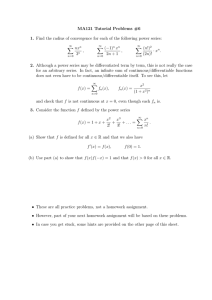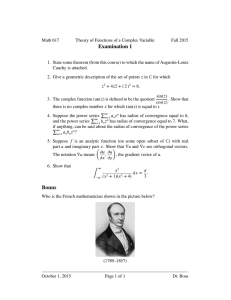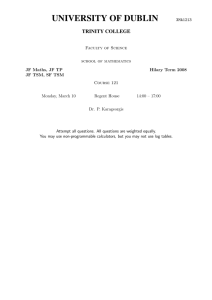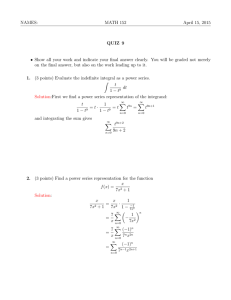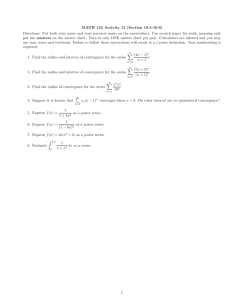Ordinary and singular points
advertisement
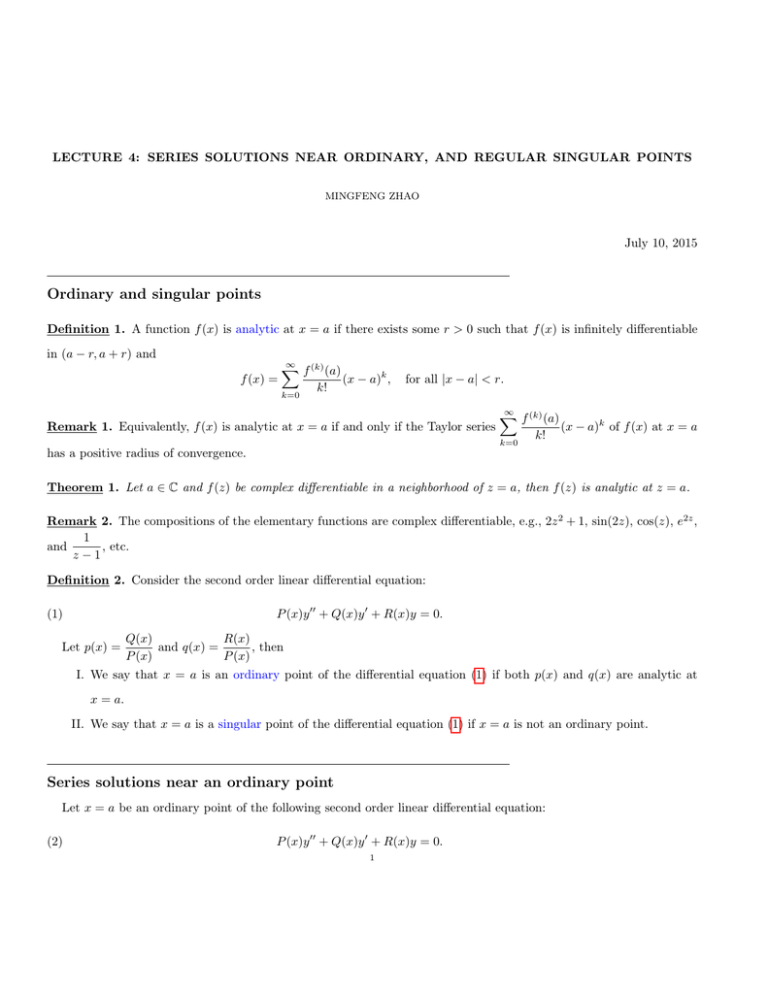
LECTURE 4: SERIES SOLUTIONS NEAR ORDINARY, AND REGULAR SINGULAR POINTS
MINGFENG ZHAO
July 10, 2015
Ordinary and singular points
Definition 1. A function f (x) is analytic at x = a if there exists some r > 0 such that f (x) is infinitely differentiable
in (a − r, a + r) and
f (x) =
∞
X
f (k) (a)
k=0
k!
(x − a)k ,
for all |x − a| < r.
Remark 1. Equivalently, f (x) is analytic at x = a if and only if the Taylor series
∞
X
f (k) (a)
k=0
k!
(x − a)k of f (x) at x = a
has a positive radius of convergence.
Theorem 1. Let a ∈ C and f (z) be complex differentiable in a neighborhood of z = a, then f (z) is analytic at z = a.
Remark 2. The compositions of the elementary functions are complex differentiable, e.g., 2z 2 + 1, sin(2z), cos(z), e2z ,
1
and
, etc.
z−1
Definition 2. Consider the second order linear differential equation:
P (x)y 00 + Q(x)y 0 + R(x)y = 0.
(1)
Let p(x) =
Q(x)
R(x)
and q(x) =
, then
P (x)
P (x)
I. We say that x = a is an ordinary point of the differential equation (1) if both p(x) and q(x) are analytic at
x = a.
II. We say that x = a is a singular point of the differential equation (1) if x = a is not an ordinary point.
Series solutions near an ordinary point
Let x = a be an ordinary point of the following second order linear differential equation:
(2)
P (x)y 00 + Q(x)y 0 + R(x)y = 0.
1
2
MINGFENG ZHAO
Q(x)
R(x)
and q(x) =
, since x = a is an ordinary point, then both p(x) and q(x) are analytic at x = a,
P (x)
P (x)
which implies that there exists some R > 0 such that
Let p(x) =
p(x) =
∞
X
p(k) (a)
k!
k=0
Let y =
∞
X
(x − a)k =:
∞
X
pk (x − a)k ,
and q(x) =
k=0
∞
X
q (k) (a)
k!
k=0
(x − a)k =:
∞
X
qk (x − a)k ,
for all |x − a| < R.
k=0
ck (x − a)k be a series solution to (2), then y 00 + p(x)y 0 + q(x)y = 0 and
k=0
y0
∞
X
=
kck (x − a)k−1
k=0
∞
X
=
kck (x − a)k−1
k=1
∞
X
=
(k + 1)ck+1 (x − a)k
k=0
y 00
∞
X
=
k(k + 1)ck+1 (x − a)k−1
k=0
∞
X
=
k(k + 1)ck+1 (x − a)k−1
k=1
∞
X
=
(k + 1)(k + 2)ck+2 (x − a)k .
k=0
Then we have
"
p(x)y 0
=
∞
X
# "
pk (x − a)k ·
k=0
=
n=0
q(x)y
=
(k + 1)ck+1 pn−k
(x − a)n
k=0
∞
X
# "
qk (x − a)
k
·
∞
X
#
k
ck (x − a)
k=0
∞
n
X
X
n=0
00
(k + 1)ck+1 (x − a)k
!
k=0
=
#
k=0
∞
n
X
X
"
∞
X
!
ck qn−k
(x − a)n .
k=0
0
Since y + p(x)y + q(x)y = 0, then
0
=
∞
X
(k + 1)(k + 2)ck+2 (x − a)k +
n=0
k=0
=
∞
X
n=0
∞
n
X
X
"
(n + 1)(n + 2)cn+2 +
n
X
!
(k + 1)ck+1 pn−k
n=0
k=0
(k + 1)ck+1 pn−k +
k=0
(x − a)n +
∞
n
X
X
n
X
k=0
!
ck qn−k
k=0
#
ck qn−k (x − a)n ,
∀|x − a| < R.
(x − a)n
LECTURE 4: SERIES SOLUTIONS NEAR ORDINARY, AND REGULAR SINGULAR POINTS
n
X
Then we get (n + 1)(n + 2)cn+2 +
(3)
cn+2 = −
(k + 1)ck+1 pn−k +
n
X
k=0
k=0
n
X
n
X
(k + 1)ck+1 pn−k +
k=0
3
ck qn−k = 0 for all n ≥ 0, that is,
ck qn−k
k=0
for all n ≥ 0.
,
(n + 2)(n + 1)
By the formula (3), the solution y is uniquely determined by the values of c0 and c1 . In fact, one can show that all
cn are linear combinations of c0 and c1 , that is, there exist two sequence {an }n=0 and {bn }∞
n=0 such that
cn = an c0 + bn c1 ,
∀n ≥ 0.
Then there general solution to (2) is given by:
y(x)
=
∞
X
cn (x − a)n
n=0
=
∞
X
[an c0 + bn c1 ](x − a)n
n=0
= c0
∞
X
an (x − a)n + c1
n=0
∞
X
bn (x − a)n .
n=0
In general, c0 and c1 as two free constants can give all solutions to (3), and the radius of convergence of the
power series solution is at least as large as the minimum of the radii of convergence of the power series
for p(x) and q(x).
Example 1. Find the general solution to the Airy equation y 00 − xy = 0 in powers of x.
∞
X
00
It’s easy to see that x = 0 is an ordinary point of y − xy = 0. Let y =
ck xk be a solution to y 00 − xy = 0, then
k=0
y0
=
∞
X
kck xk−1
k=0
=
∞
X
kck xk−1
k=1
=
∞
X
(k + 1)ck+1 xk
k=0
y 00
=
∞
X
k(k + 1)ck+1 xk−1
k=0
=
∞
X
k=1
k(k + 1)ck+1 xk−1
4
MINGFENG ZHAO
∞
X
=
(k + 1)(k + 2)ck+2 xk
k=0
= y 00 − xy
0
∞
X
=
(k + 1)(k + 2)ck+2 xk − x
k=0
∞
X
=
=
ck xk
k=0
(k + 1)(k + 2)ck+2 xk −
∞
X
k=0
k=0
∞
X
∞
X
(k + 1)(k + 2)ck+2 xk −
k=0
=
∞
X
ck xk+1
ck−1 xk
k=1
2c2 +
∞
X
[(k + 1)(k + 2)ck+2 − ck−1 ] xk .
k=1
So 2c2 = 0 and (k + 1)(k + 2)ck+2 − ck−1 = 0 for all k ≥ 1, that is,
c2 = 0,
and
ck+2 =
1
· ck−1 ,
(k + 2)(k + 1)
for all k ≥ 1.
Then
(1) If we start from c0 , then c0 → c3 → c6 → · · · → c3n → · · · , that is,
c3n
=
=
=
=
1
(3n)(3n − 1)
1
(3n)(3n − 1)
1
(3n)(3n − 1)
c0
n
Y
k=1
· c3n−3
1
· c3n−6
(3n − 3)(3n − 4)
1
1
·
· ··· ·
· c0
(3n − 3)(3n − 4)
3·2
·
1
.
(3k)(3k − 1)
.
(2) If we start from c1 , then c1 → c4 → c7 → · · · → c3n+1 → · · · , that is,
c3n+1
=
=
=
1
(3n + 1)(3n)
1
(3n + 1)(3n)
1
(3n + 1)(3n)
= c1
n
Y
k=1
.
· c3n−2
1
· c3n−5
(3n − 2)(3n − 3)
1
1
·
· ··· ·
· c1
(3n − 2)(3n − 3)
4·3
·
1
.
(3k + 1)(3k)
LECTURE 4: SERIES SOLUTIONS NEAR ORDINARY, AND REGULAR SINGULAR POINTS
5
(3) If we start from c2 , then c2 → c5 → c8 → · · · → c3n+2 → · · · , that is,
c3n+2
=
=
=
=
1
(3n + 2)(3n + 1)
1
(3n + 2)(3n + 1)
1
(3n + 2)(3n + 1)
· c3n−1
1
· c3n−4
(3n − 1)(3n − 2)
1
1
·
· ··· ·
· c2
(3n − 1)(3n − 2)
5·4
·
0.
.
So we get
y
=
∞
X
ck xk
k=0
=
∞
X
c3n x3n +
n=0
∞
X
c3n+1 x3n+1 +
n=0
= c0 + c1 x + c0
∞
X
c3n+2 x3n+2
n=0
∞
X
n
Y
n=1
k=1
1
(3k)(3k − 1)
!
x
3n
+ c1
∞
X
n
Y
n=1
k=1
1
(3k + 1)(3k)
!
x3n+1 .
Let
y1 (x)
=
1+
y2 (x)
= x+
x6
x3n
x3
+
+
+ ···
2 · 3 2 · 3 · 5 · 6 2 · 3 · 5 · 6 · · · · · (3n − 1)(3n)
x4
x7
x3n+1
+
+ ··· +
+ ··· .
3·4 3·4·6·7
3 · 4 · 6 · 7 · · · · · (3n)(3n + 1)
It’s clear that y1 (x) and y2 (x) are linearly independent, then y1 (x) and y2 (x) form a fundamental set of solutions to
y 00 − xy = 0. Therefore, the general solution to y 00 − xy = 0 is given by:
y = C1 y1 (x) + C2 y2 (x) .
Since p(x) = 0 and q(x) = −x, then the radius of convergence of the power series at x = 0 for both p(x) and q(x) are
infinity, which implies that the radius of convergence for the above series solution is also infinity.
Example 2. Find the general solution to the Airy equation y 00 − xy = 0 in powers of x − 1.
∞
X
Since −x = −1 + −(x − 1), then x = 1 is an ordinary point of y 00 − xy = 0. Let y =
ck (x − 1)k be a solution to
k=0
y 00 − xy = 0, then
y0
=
∞
X
k=0
kck (x − 1)k−1
6
MINGFENG ZHAO
∞
X
=
kck (x − 1)k−1
k=1
∞
X
=
(k + 1)ck+1 (x − 1)k
k=0
y 00
∞
X
=
k(k + 1)ck+1 (x − 1)k−1
k=0
∞
X
=
k(k + 1)ck+1 (x − 1)k−1
k=1
∞
X
=
(k + 1)(k + 2)ck+2 (x − 1)k
k=0
xy
=
(x − 1 + 1)y
=
(x − 1)y + y
=
(x − 1)
∞
X
ck (x − 1)k +
k=0
∞
X
=
=
ck (x − 1)k+1 +
∞
X
ck (x − 1)k
k=0
ck−1 (x − 1)k +
k=1
=
ck (x − 1)k
k=0
k=0
∞
X
∞
X
c0 +
∞
X
ck (x − 1)k
k=0
∞
X
[ck−1 + ck ](x − 1)k .
k=1
Since y 00 − xy = 0, then we get
0
=
∞
X
(k + 1)(k + 2)ck+2 (x − 1)k − c0 −
k=0
=
∞
X
[ck−1 + ck ](x − 1)k
k=1
2c2 − c0 +
∞
X
[(k + 1)(k + 2)ck+2 − ck − ck−1 ] (x − 1)k .
k=1
So 2c2 − c0 = 0 and (k + 1)(k + 2)ck+2 − ck − ck−1 = 0 for all k ≥ 1, that is,
c2 =
c0
,
2
and
ck+2 =
ck + ck−1
,
(k + 2)(k + 1)
Then
c3
=
=
c1 + c0
3·2
c0
c1
+
6
6
for all k ≥ 1.
LECTURE 4: SERIES SOLUTIONS NEAR ORDINARY, AND REGULAR SINGULAR POINTS
c4
=
=
=
c5
=
=
=
=
7
c2 + c1
4·3
c2
c1
+
12 12
c1
c0
+
12 24
c3 + c2
5·4
c2
c3
+
20 20
c0
c0
c1
+
+
40 120 120
c0
c1
+
30 120
So we get
y
=
=
c
c
c
c0
c1 c0 c1 0
1
0
c0 + c1 (x − 1) + (x − 1)2 +
+
(x − 1)3 +
+
(x − 1)4 +
+
(x − 1)5 + · · ·
2
6
6
12 24
30 120
(x − 1)3
(x − 1)4
(x − 1)5
(x − 1)2
+
+
+
+ ···
c0 1 +
2
6
24
30
(x − 1)3
(x − 1)4
(x − 1)5
+c1 (x − 1) +
+
+
+ ···
6
12
120
Let
y1 (x)
=
y2 (x)
=
(x − 1)2
(x − 1)3
(x − 1)4
(x − 1)5
+
+
+
+ ···
2
6
24
30
(x − 1)3
(x − 1)4
(x − 1)5
(x − 1) +
+
+
+ ··· .
6
12
120
1+
It’s clear that y1 (x) and y2 (x) are linearly independent, then y1 (x) and y2 (x) form a fundamental set of solutions to
y 00 − xy = 0. Therefore, the general solution to y 00 − xy = 0 is given by:
y = C1 y1 (x) + C2 y2 (x) .
Since p(x) = 0 and q(x) = −x, then the radius of convergence of the power series at x = 1 for both p(x) and q(x) are
infinity, which implies that the radius of convergence for the above series solution is also infinity.
Radius of convergence of the series solutions near an ordinary point
Theorem 2. Let f (z) be a complex differentiable function except at finitely many points z1 , z2 , · · · , zn in the complex
plane C, then for any complex number z0 ∈
/ {z1 , z2 , · · · , zn }, the radius of convergence of the Taylor series of f (z) at
8
MINGFENG ZHAO
z = z0 is given by:
R = min{|z0 − z1 |, |z0 − z2 |, · · · , z0 − zn |}.
Example 3. Find the radius of convergence of the Taylor series for
1
about x = 0.
1 + x2
1
, solve 1 + z 2 = 0, then z = ±i, that is, f (z) is differentiable except at z = ±i. By Theorem 2,
1 + z2
1
about x = 0 is:
the radius of convergence of the Taylor series for
1 + x2
Let f (z) =
R = min{|0 − i|, |0 + i|} = 1.
Example 4. Find the radius of convergence of the Taylor series for
Let f (z) =
1
(1 +
z 2 )(z 2
− 2z + 2)
1
(1 +
x2 )(x2
− 2x + 2)
about x = 0.
, solve z 2 − 2z + 2 = 0, then z = ±i or z = 1 ± i, that is, f (z) is differentiable except
at z = ±i and z = 1 ± i. By Theorem 2, the radius of convergence of the Taylor series for
x2
1
about x = 0 is:
− 2x + 2
R = min{|0 − i|, |0 + i|, |0 − 1 − i|, |0 − 1 + i|} = 1.
Example 5. Determine a lower bound for the radius of convergence of series solutions about x = 0 for the Legendre
equation
(1 − x2 )y 00 − 2xy 0 + α(α + 1)y = 0.
where α is a constant.
Since (1 − x2 )y 00 − 2xy 0 + α(α + 1)y = 0, then we get
y 00 −
2x 0 α(α + 1)
y +
y = 0.
1 − x2
1 − x2
2z
α(α + 1)
and g(z) =
, solve 1 − z 2 = 0, then z = ±1, that is, f (z), g(z) are differentiable except
1 − z2
1 − z2
2x
α(α + 1)
at z = ±1. By Theorem 2, the radius of convergence of the Taylor series for −
and
about x = 0 is:
1 − x2
1 − x2
Let f (z) = −
R = min{|0 − 1|, |0 + 1|} = 1.
Hence, a series solution of the form
∞
X
an xn converges at least for |x| < 1.
n=0
Remark 3. When α = 1, we get (1 − x2 )y 00 − 2xy 0 + 2y = 0, it’s easy to see that y = x is a solution which has infinite
radius of convergence.
LECTURE 4: SERIES SOLUTIONS NEAR ORDINARY, AND REGULAR SINGULAR POINTS
9
Example 6. Determine a lower bound for the radius of convergence of series solutions of the differential equation
(1 + x2 )y 00 + 2xy 0 + 4x2 y = 0
1
about the point x = 0; about the point x = − .
2
Since (1 + x2 )y 00 + 2xy 0 + 4x2 y = 0, then we get
y 00 +
4x2
2x 0
y +
y = 0.
2
1+x
1 + x2
2z
4z 2
and
g(z)
=
, solve 1 + z 2 = 0, then z = ±i, that is, f (z), g(z) are differentiable except at
1 + z2
1 + z2
z = ±i. By Theorem 2, then
Let f (z) =
• The radius of convergence of the Taylor series for
2x
4x2
and
about x = 0 is:
2
1+x
1 + x2
R = min{|0 − i|, |0 + i|} = 1.
Hence, a series solution of the form
∞
X
an xn converges at least for |x| < 1.
n=0
4x2
1
2x
and
about x = − is:
1 + x2
1 + x2
2
√
1
1
5
R = min{| − − i||, | − + i|} =
.
2
2
2
• The radius of convergence of the Taylor series for
Hence, a series solution of the form
∞
X
1
an (x + )n converges at least for |x + 12 | <
2
n=0
√
5
2 .
Example 7. Determine a lower bound for the radius of convergence of series solutions of the differential equation
(1 − x2 )y 00 + (1 − x)y 0 + y = 0.
about the point x = 0.
Since (1 − x2 )y 00 + (1 − x)y 0 + y = 0, then
y 00 +
1−x 0
1
y +
y = 0.
2
1−x
1 − x2
y 00 +
1
1
y0 +
y = 0.
1+x
1 − x2
That is, we get
1
1
and g(z) =
, then f (z) is differentiable except at z = −1, and g(z) is differentiable except at
1+z
1 − z2
1
z = ±1. By Theorem 2, the radius of convergence of the Taylor series for
about x = 0 is |0 − 1| = 1, and the
1+x
Let f (z) =
10
MINGFENG ZHAO
radius of convergence of the Taylor series for
the form
∞
X
1
about x = 0 is min{|0 − 1|, |0 + 1|} = 1. Hence, a series solution of
1 − x2
an xn converges at least for |x| < 1.
n=0
Regular and irregular singular points
Definition 3. Consider the second order linear differential equation:
P (x)y 00 + Q(x)y 0 + R(x)y = 0.
(4)
Let p(x) =
Q(x)
R(x)
and q(x) =
, then
P (x)
P (x)
I. We say that x = a is a regular singular point of the differential equation (4) if x = a is a singular point and
both (x − a)p(x) and (x − a)2 q(x) have convergent Taylor series about x = a.
II. We say that x = a is an irregular singular point of the differential equation (4) if x = a is a singular point but
x = a is not a regular singular point.
Theorem 3. Let a ∈ C, R > 0 and f (z) be complex differentiable for 0 < |z − a| < R, if there exists some non-negative
integer n such that
lim (z − a)n f (z)
z→a
exists,
then (z − a)n f (z) is analytic for all |z − a| < R.
Remark 4. If p(z) and q(z) are complex differentiable for 0 < |z − a| < R, and a is a singular point of the differential
equation y 00 + p(x)y 0 + q(x)y = 0, then a is regular if and only if the limits
lim (z − a)p(z)
z→a
and
lim (z − a)2 q(x)
z→a
Example 8. Determine the singular points of the Legendre equation
(1 − x2 )y 00 − 2xy 0 + α(α + 1)y = 0.
and determine whether they are regular or irregular.
Since Since (1 − x2 )y 00 − 2xy 0 + α(α + 1)y = 0, then we get
y 00 −
2x 0 α(α + 1)
y +
y = 0.
1 − x2
1 − x2
exist.
LECTURE 4: SERIES SOLUTIONS NEAR ORDINARY, AND REGULAR SINGULAR POINTS
Then we have two singular points x = ±1. It’s easy to see that −
11
α(α + 1)
2z
and
are complex differentiable
2
1−z
1 − z2
except at z = ±1. Notice that
2z
lim (z − 1) · −
z→1
1 − z2
=
α(α + 1)
lim (z − 1)2 ·
1 − z2
2z
lim (z + 1) · −
z→−1
1 − z2
lim (z + 1)2 ·
z→1
=
α(α + 1)
1 − z2
2z
=1
z+1
α(α + 1)(z − 1)
=0
z+1
2z
=1
z−1
lim −
=
z→1
z→−1
lim
z→1
lim
z→−1
lim −
=
z→−1
α(α + 1)(z + 1)
= 0.
z−1
Therefore, the points x = ±1 are regular singular points.
Example 9. Determine the singular points of the differential equation
2x(x − 2)2 y 00 + 3xy 0 + (x − 2)y = 0
and classify them as regular or irregular.
Since 2x(x − 2)2 y 00 + 3xy 0 + (x − 2)y = 0, then
y 00 +
x−2
3x
y0 +
y = 0.
2x(x − 2)2
2x(x − 2)2
That is, we get
y 00 +
3
1
y0 +
y = 0.
2
2(x − 2)
2x(x − 2)
Then we have two singular points x = 2 and x = 0. It’s easy to see that
1
3
and
are complex
2(z − 2)2
2z(z − 2)
differentiable except at z = 0 and z = 2. Notice that
3
z→2
2(z − 2)2
3
lim z ·
z→0
2(z − 2)2
1
lim z 2 ·
z→0
2z(z − 2)
lim (z − 2) ·
=
=
=
3
does not exist
z→2 2(z − 2)
3z
lim
=0
z→0 2(z − 2)2
z
lim
= 0.
→0 2(z − 2)
lim
Therefore, x = 2 is an irregular singular point, and x = 0 is a regular singular point.
Department of Mathematics, The University of British Columbia, Room 121, 1984 Mathematics Road, Vancouver, B.C.
Canada V6T 1Z2
E-mail address: mingfeng@math.ubc.ca
